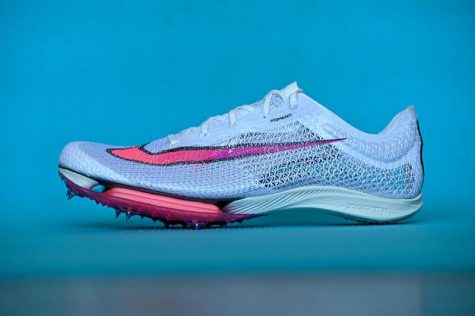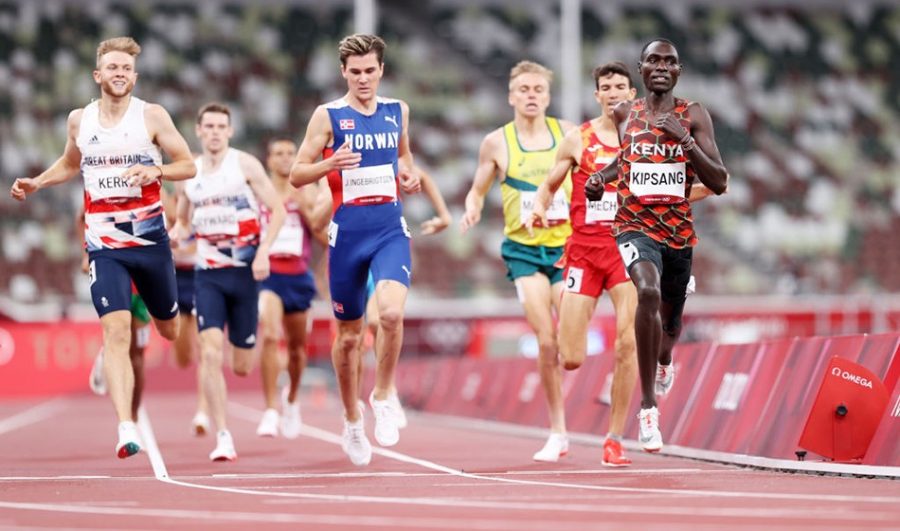Legal Doping? The Footprint of Shoe Technology
October 13, 2021
The sport of track and field has developed a reputation for performance-enhancing drugs. Despite the World Anti-Doping Agency’s attempts to enforce its laws with regular testing, many top-level athletes can’t help but wonder if some fellow competitors at the start line are dopers. However, there is now a situation that would make most athletes in the sport dopers as well—and no, it’s not due to steroids. Instead, it’s the shoes and spikes on their feet that are now considered performance enhancing, leading many to question the integrity of the sport.
The problem began in 2019, when the Nike ZoomX Vaporfly Next% was released, changing the sport of running forever. Made of a thick but remarkably lightweight Pebax foam midsole called “ZoomX” and a stiff, rebounding carbon plate, the energy return with each stride was said to be about 85% (it was previously 60-70%), and runners saw 4-6% increases in their personal bests. Not long after, the next iteration was released, the AlphaFly Next%, which had similar effects. These were met with controversy, especially after marathoner Eliud Kipchoge’s breaking the two-hour record. Many started to wonder if it were the shoes or the athlete that was breaking records. In 2020, World Athletics, the governing body of the sport, eventually announced a new set of guidelines that would restrict these shoes from certain distances and competitions.

The story didn’t end there, however, as this year’s Olympics saw the issue move from road races to the track. As other brands started innovating and building their own “super shoe,” many people thought that the gap between Nike and their competitors would begin to close. Unfortunately for its rivals, Nike was already ahead of the game. Using the same technology found in their infamous marathon shoes, the company produced track spikes meant for races ranging from the 100 meters all the way up to the 10,000 meters.
Once the prototypes of these Nike spikes found the feet of athletes, national and world records were broken left and right. In 2020 alone, the 5000-meter world records for both genders, the men’s 10,000 meter run, the one-hour run on the track, and many others both national and global were shattered. Furthermore, in 2021, Nike was planning to release the Viperflys, a pair of sprint spikes that were so feared—as many believed less-talented athletes might now break Usain Bolt’s historic records—that the spikes were abolished before they were even released.

By the time the Tokyo Olympics rolled around, it was clear who was making the best spikes, and there was no doubt that these spikes had some sort of effect on the runners. In many of the distance races during the Olympics, some athletes wore shoes that had no logo, whited out, spikes during their competitions. This was because many athletes were sponsored by brands other than Nike, but in order to give their athletes a level playing field, sponsors let them wear competitors’ spikes if athletes covered the famous swoosh. Sprinters such as Norway’s Karsten Warholm, who won the 400-meter hurdles, criticized his competitors for wearing Nike spikes, claiming that they had the sensation of trampolines and “takes credibility away from the sport.”
Other brands are doing their best to try and catch up to Nike’s monopoly in the running-shoe market. Brands such as Asics, Adidas, New Balance, and others have built shoes that world-class athletes wear. As for track spikes, brands such as New Balance and Adidas have produced spikes that threaten Nike’s reign, and spikes by other brands are in the works.
The essential question regarding these shoes is whether or not they represent innovation in the sport, or just a different form of “doping.” It’s hard to ignore the records being broken by athletes wearing these technologically advanced shoes, but without new shifts in technology, there’s no growth in the industry. Critics wonder if these athletes are working as hard as generations before them, or if the shoes account for their improvement. Whatever the case, advanced shoe technology will continue to complicate the world of the track and field.




















